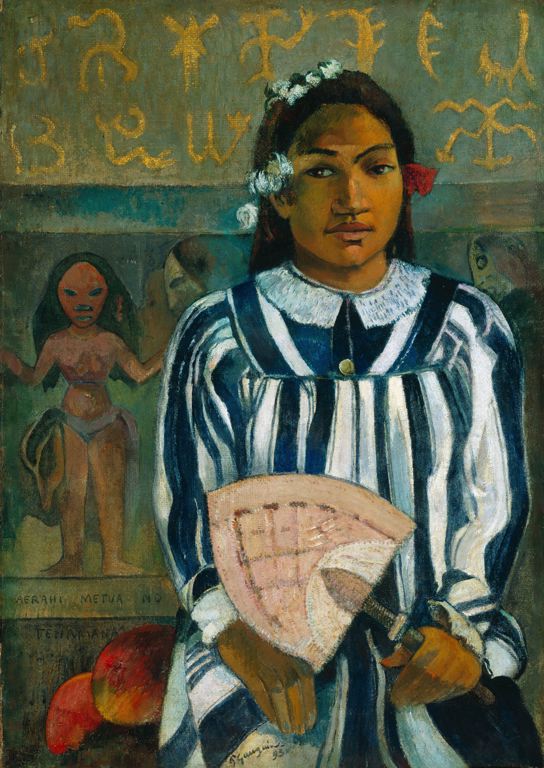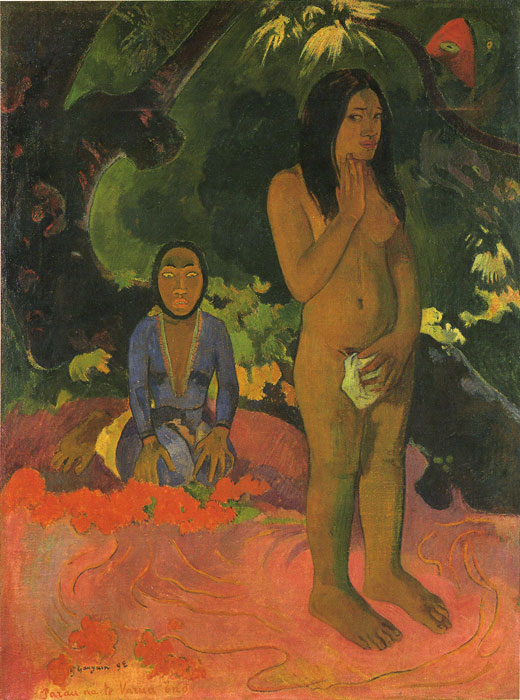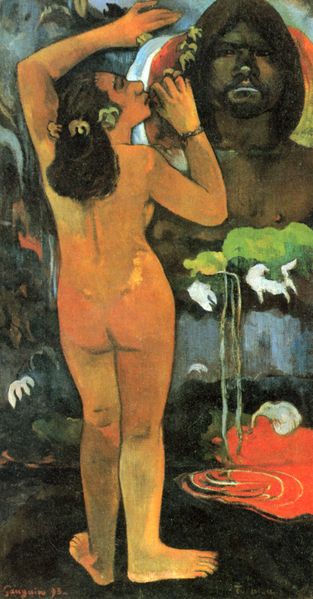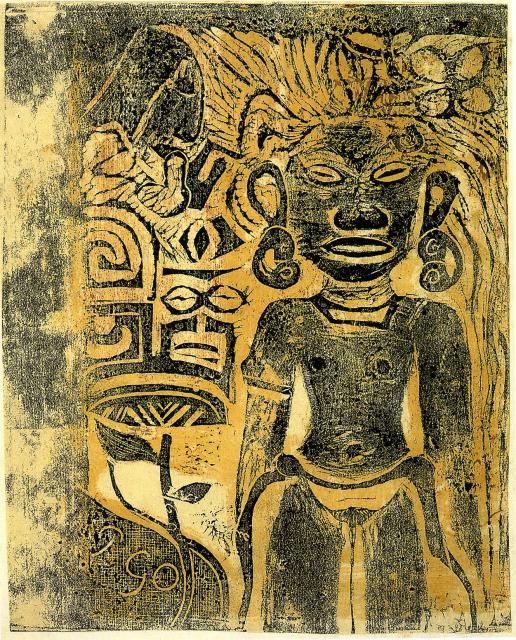”Where do we come from? What are we? Where are we going?” Having presented the questions so handsomely, in his greatest painting, it hardly seems to matter that Paul Gauguin had none of the answers.
To look for allegorical meanings in Gauguin’s greatest work appears to be an invitation to embark on a fool’s errand. Gauguin’s implication that his title was a mere afterthought is somewhat hard to swallow in the light of events leading up to and immediately following the execution of the painting. Knowing noting of its genesis, or even of its content, we can still admire the organization of color, line and pattern in ”Where Do We Come From?” and still marvel at its glowing topical light. Still, a nagging question remains which is what exactly are is the viewer looking at? That question is best answered through some biographical data on Gauguin to know where did Gauguin come from? What was he? and Where was he going?
By the time Gauguin decided, belatedly, and irrevocably, to devote his life to art, the most controversial innovation in the history of painting, impressionism, had won a measure of acceptance. The disturbance that it once caused now seems altogether disproportionate to the small measure of radicalism the style really embodied. The much misunderstood aim of impressionism was the achievement of a more credible realism, and the adherents of the style were more concerned with evolution than revolution.
Gauguin’s was another story. After a brief flirtation with impressionism, he began to grope toward was he called a synthesis of form and color; an idea that was then in the air and that soon was to crystallize in the artist Maurice Denis’s definition of a painting as a flat surface covered with colors arranged in a certain order. The notion was more revolutionary than would first appear. After having confused itself with sculpture for centuries, painting was about to reassume its own identity as a two dimensional art. If Paul Gauguin was not the sole inventor of the concept, his Tahitian canvases were its most persuasive argument. When first shown in Europe, they were held to be incomprehensible by all but a few of the more perceptive critics.
This was understandable. In the course of a few short years, and largely through the efforts of a single man, painting had undergone a complete metamorphosis. It would never again be quite the same. Gauguin’s contemporaries found his colors bizarre, his drawings crude, and his forms flat an unconvincing. They were not yet able to concede that paintings could exist on their own terms, independent of both external reality and established conventions. However, no such hesitation impeded public acceptance of the content of Gauguin’s pictures, which were taken to be literal illustrations of Tahitian life and mythology. Posterity has chosen to see the particualr in the universal and to cast its image of Tahiti in Gauguin’s mold.
Since Gauguin’s death in 1903, much has been llearned about the indigenous arts of the South Pacific that was not known in his time. The enormous idols dominating ”The Feast of Hina” and ”Where Do We Come From”, were the products of Gauguin’s fanciful approach to the Tahitian scene and its mythology, and that effigies in other paintings had no real counterparts in tahitian sculpture but were derivations and composites of Indian, Javan, and ancient Egyptian religious art. Still, the notion endured that the remainder of Gauguin’s Tahiti, the idyllic settings peopled by childlike, unspoiled beings, may be taken as a literal transcript of what the artist found in the colony.
By the time Gauguin reached Papeete in 1891, the Eden he had sought, his quest for living statues from man’s primeval age, had long since vanished. The thatched roofs he envisioned had been replaced by corrugated iron and the natives were happier eating in Chinese restaurants than harvesting the gifts of nature. The living statues, their wonted postures, libidinous and drunken, were anything but statuesque. Diseases of a varities were so prevalent that the native population was in danger of extinction. Nevertheless, despite the grotesque mayhem, there is nothing in his paintings to indicate that the island was anything less than a paradise on earth.
 h="544" height="768" />
h="544" height="768" />Gauguin, The Ancestors of Tehamana
Clearly, gauguin was not above stretching the truth when it suited his purposes. Not the least of his flagrant deceptions is his claim to have received a thorough grounding in Tahitian theology from the first of a series of nymphet wives. This was completely false since missionaries of different faiths had been proselytizing for a hundred years and nothing remained of the ancient tahitian religion and mythology. The Pagan gods were forgotten.
Gauguin returned to France in 1893, and except for coming into an inheritance, the sejour was not successful. His art was derided. He had not abandoned his idea of finding a South Seas paradise and in 1895 he again left France. His destination was Samoa, but a brief stopover in Tahiti stretched into six years, much of which time Gauguin spent in bickering with the ecclesiastic and secular authorities of Punaauia and Papeete, in conducting a series of cranky legal squabbles, and in two separate excursions into muckraking journalism. Somehow, he managed to find time to dash off a number of his most famous paintings, including ”Where Do We Come From?”
It would be an understatement to say that Gauguin’s personal circumstances at the time were not conducive to an optimistic view of humankind’s fate, or even to a clearly thought out pessimistic view. He had suffered a series of heart attacks, his body was a mass of syphilitic lesions, his eyesight was failing and an ankle he had broken in a brawl in Brittany was an almost constant source of excruciating pain and had driven him to the use of morphine. He also suffered bouts of fever, along with dizziness and in all probability, malnutrition. Furthermore, he had alienated the European community and had received word that his daughter Aline was dead.
At the beginning of 1898 he tried to kill himself and failed. But shortly before his botched attempt at suicide he determined to have one last go at crystallizing his broodings on canvas. The painting he executed, ”Where Do We Come From?”, was intended to be his spiritual testament. Considered solely on its aesthetic merits, it is not only Gauguin’s ultimate masterpiece but conceivably one of the prime works of art of the last 150 years. Gauguin,’s paintings were not illustrations of his rather muddled ideas, but voyages of discovery in which the form and subject , vague at first and only partially understood, became clear to him in the process of creation.
Some of the motifs of the picture have been traced to their sources with reasonable exactitude. One of these is the terminal figure of the old woman, a figure that recurs with frequency in Gauguin’s works. it is related in some way to his persistent fascination wit the Biblical Eve and is part of a cradle to grave cycle. The ”idol” represents the artist’s conception of Hina, the Polynesian moon goddess and giver of all life. More important than the content , ”Where Do We Come From?” is a massive refutation of impresionist theory. Gauguin fuses opposites; sunlight and moonlight, night and day, the warm vibrancy of life and the cold stillness of death, in an almost musical evocation of the human condition. It is an evocation realized almost entirely thorough abstract elements and it would hardly have been less compelling had there been no recognizable figures or objects on the canvas.
”Where Do We Come From” is almost like a mural, a fresco in which the forms are invested with an amplitude and simplicity that was heretofore unprecedented. The color glows and mutes in a sweeping orchestration no smaller canvas could accommodate. Gauguin tried to be a savage, but failed. He could not escape being a rational Westerner who tries to understand and analyze everything, including the problems of life and death. These reflections on metaphysical problems for which there are no solutions must inevitably lead to unhappiness resulting in art that is a testament to the futility of words and to the futility of life.
For gauguin, what Eden there was, was within him, in a strange dream world in which both the rational and ”savage” nature took turn asserting themselves. These are intangible dreams resulting in an essence of art work that derives from what is not expressed. Given his circumstances it is little wonder that the Eden he painted is a place pervaded with melancholy; one of the most poignant and haunting places in all of art.









 COMMENTS
COMMENTS